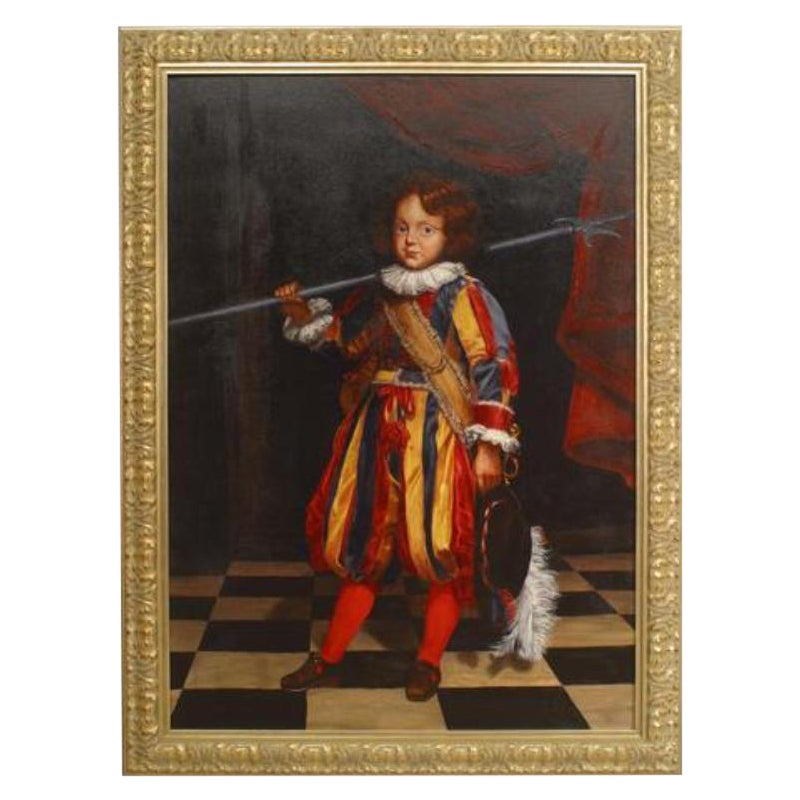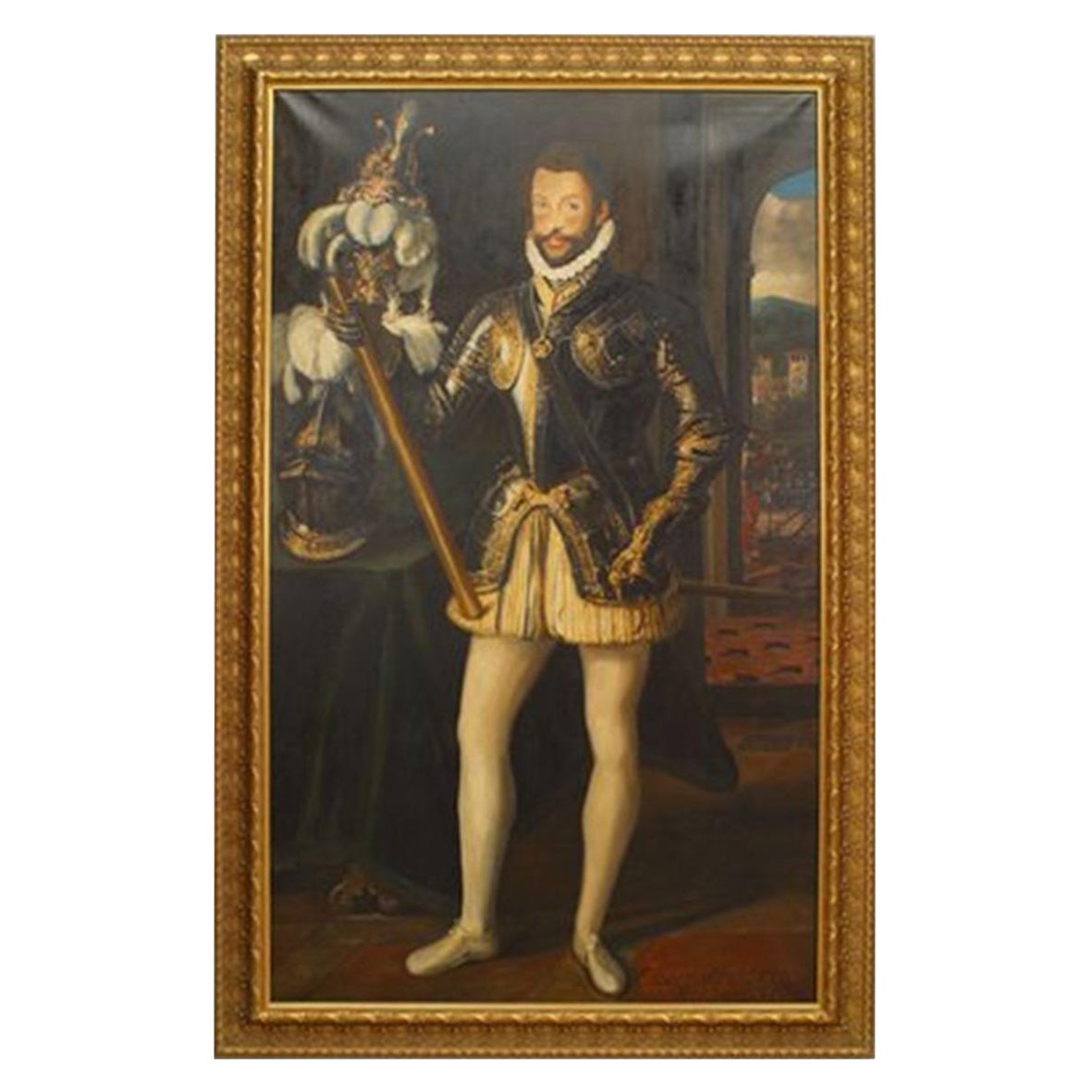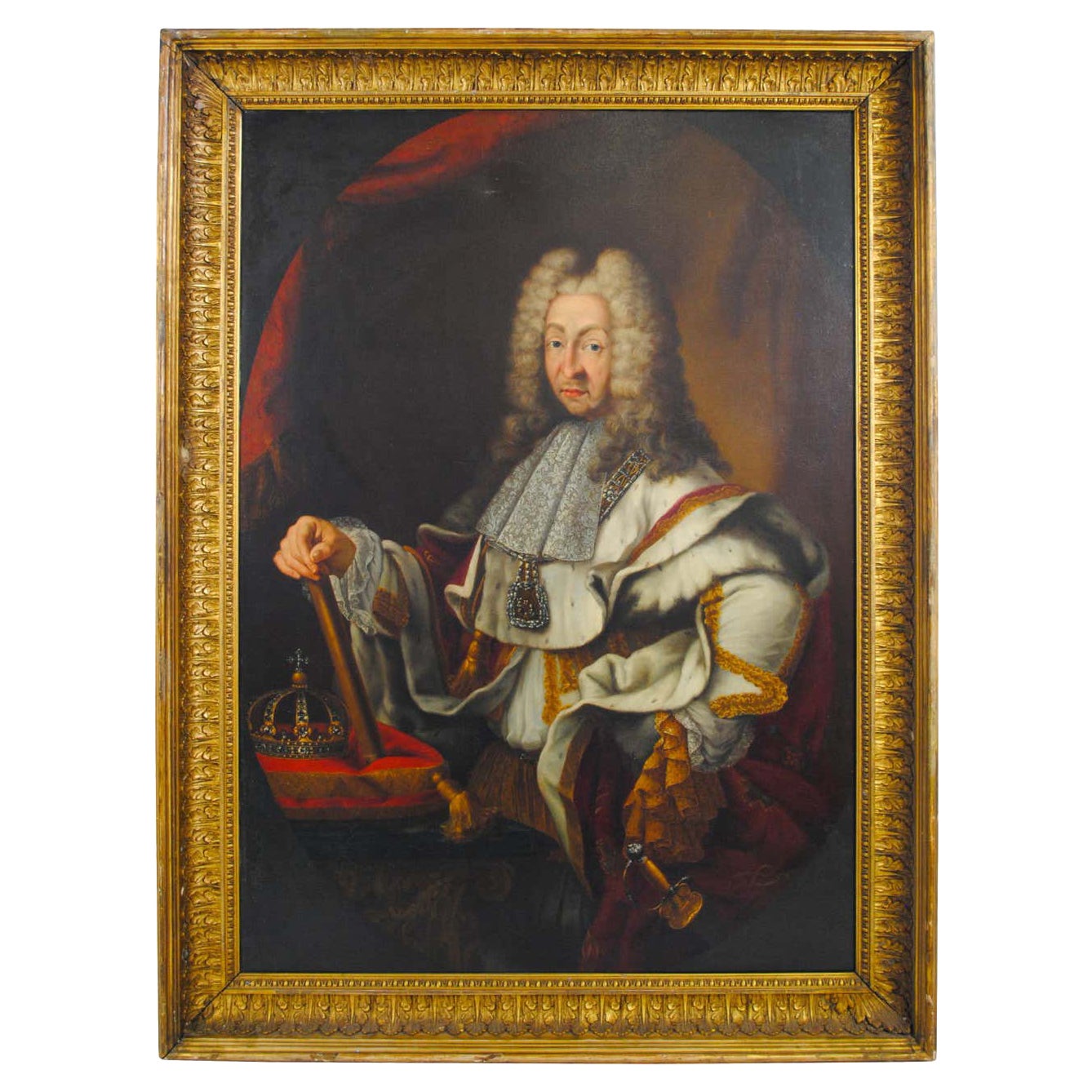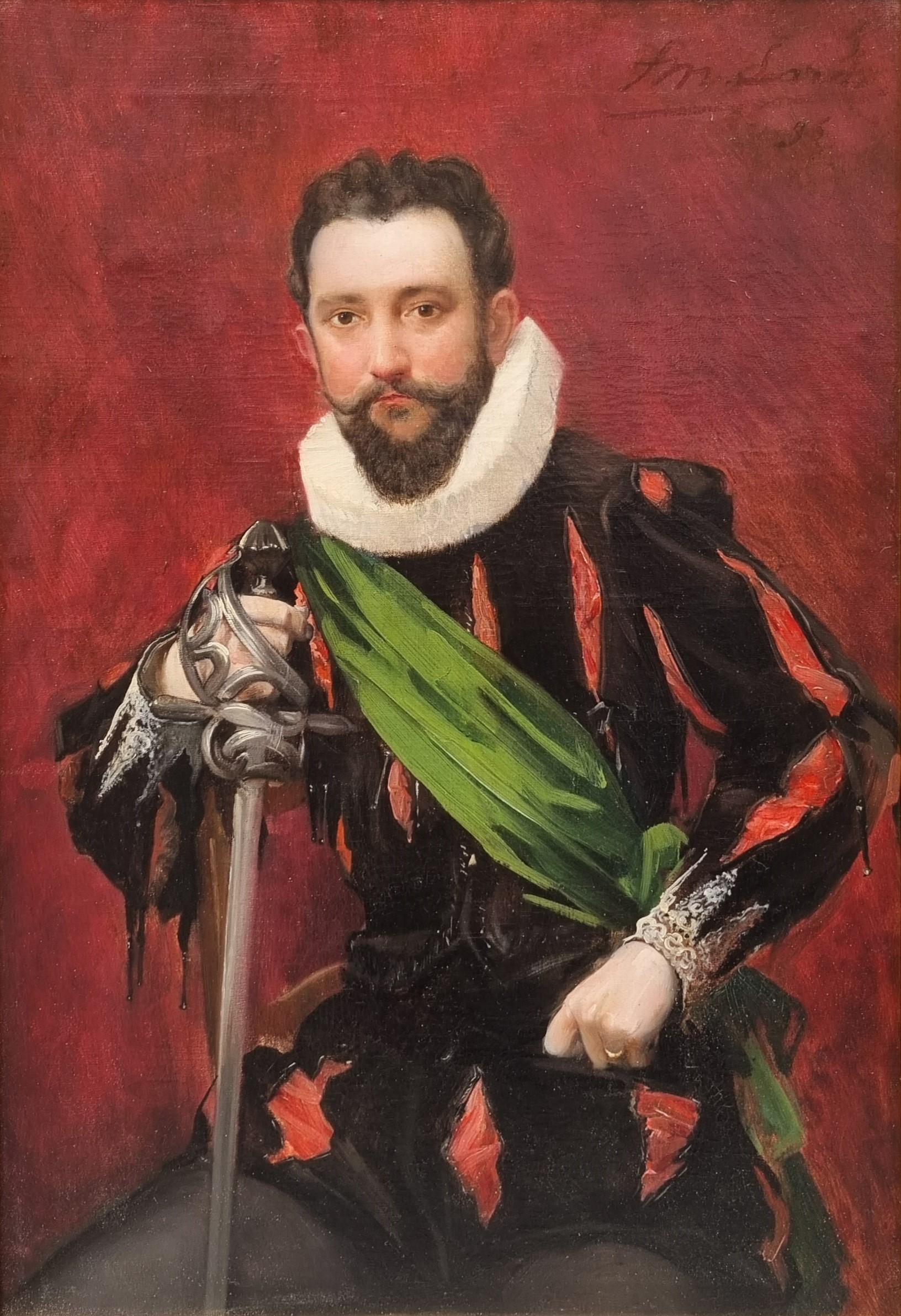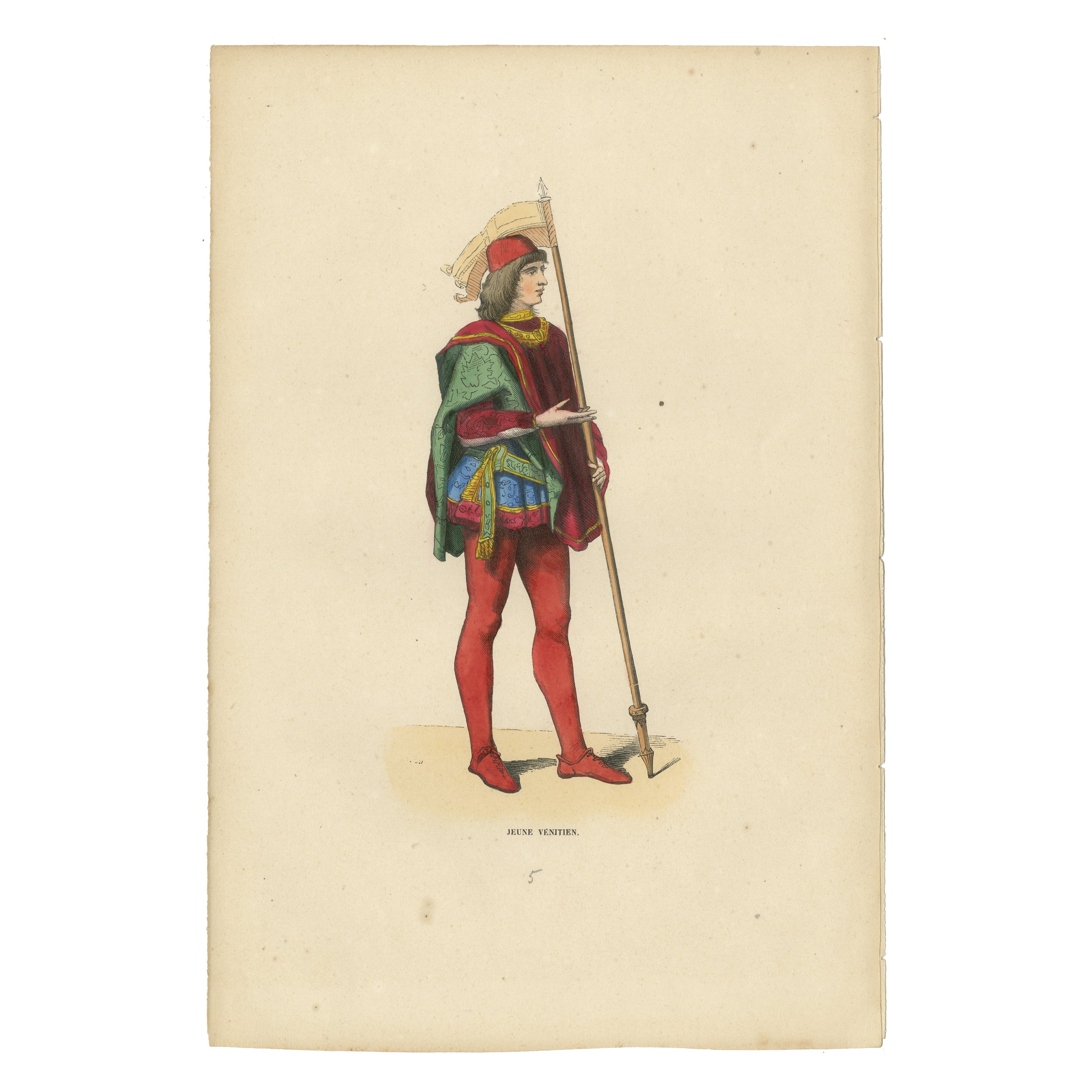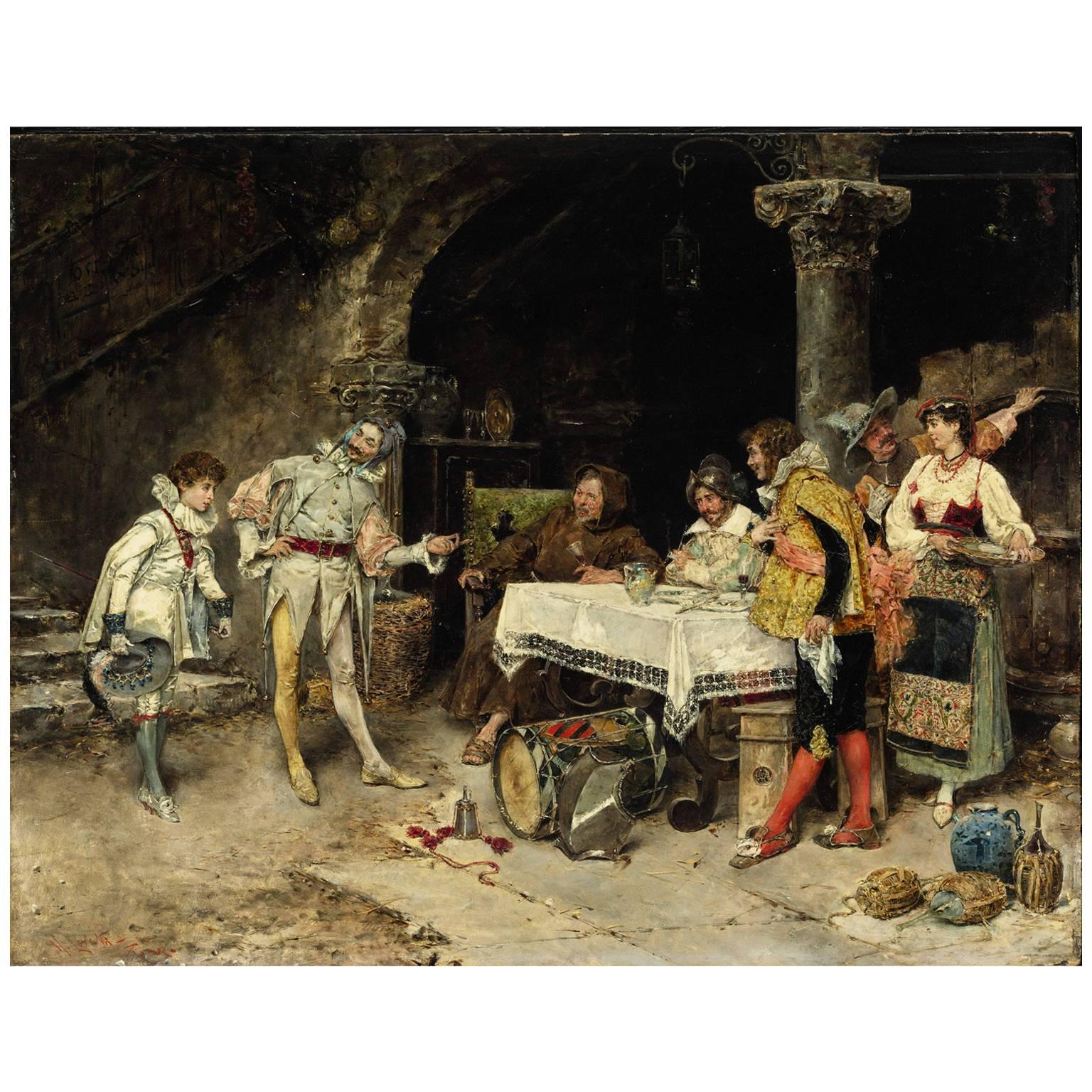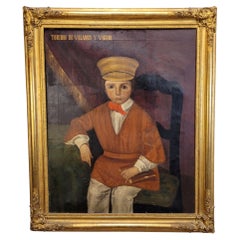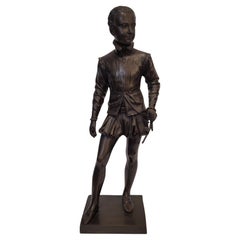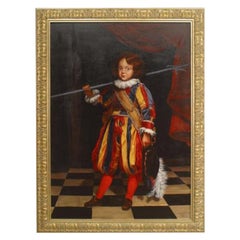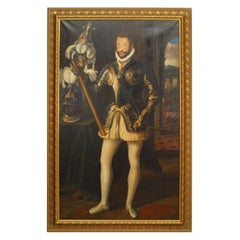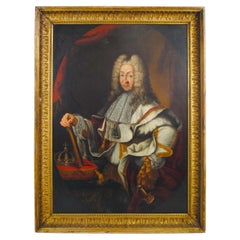Items Similar to Spanish Painting Portrait“Castilian Macebearer”José Alcázar Tejedor Roma school
Video Loading
Want more images or videos?
Request additional images or videos from the seller
1 of 22
Spanish Painting Portrait“Castilian Macebearer”José Alcázar Tejedor Roma school
$7,195.07
$9,917.2127% Off
£5,352.41
£7,377.4027% Off
€6,000
€8,27027% Off
CA$9,852.52
CA$13,580.0527% Off
A$10,954.66
A$15,099.1727% Off
CHF 5,719.92
CHF 7,883.9527% Off
MX$133,344.86
MX$183,793.6627% Off
NOK 72,983.66
NOK 100,595.8127% Off
SEK 68,382.20
SEK 94,253.4727% Off
DKK 45,674.69
DKK 62,954.9427% Off
Shipping
Retrieving quote...The 1stDibs Promise:
Authenticity Guarantee,
Money-Back Guarantee,
24-Hour Cancellation
About the Item
One of a kind and very Excellent oil on canvas, signed, dated 1880 and located in Rome, work of José Alcázar Tejedor. It represents a mace-bearer, the absolute protagonist of the scene, which derives from his clothing and, mainly, because he carries the ceremonial mace. This attire dates back to medieval times. The original outfit is called a tabard. This clothing was worn by monarchs and kings of arms, later passing to the heralds and mace-bearers of courts and town councils. The character's fabrics are of a rich red velvet; vibrant colours, gold embroidery... suggest the character's recognition. He also wears red stockings, a doublet and an undershirt.
In this outfit, different heraldic motifs are represented. If it is read as a quartered shield, the reading would be the following: In 1 of Castile: in a gules field a gold castle cleared with azure; in 2: of Leon, in a silver field a rampant lion of purple crowned with gold, armed and lampased with gules. In 3 of Aragon: in a gold field four poles of gules. In 4: quartered in the cross of Aragon and the Kingdom of Sicily: 1 and 3, in a gold field four poles of gules; 2 and 4, in a silver field a sable eagle crowned with gold and beaked and limbed with gules. These motifs can also be seen in the character's cape, with a border of gold castles on a gules field.
The figure occupies the centre of the composition and stands out for the richness of the details in his attire, contrasting with the architectural background of neutral tones. Warm tones predominate, such as the red of the attire and the gold of the embroidery. The greyish background further highlights the chromatic details. The lights and shadows are delicately worked, especially in the folds of the clothing, which contributes to the sensation of volume.
The work shows great realism in the treatment of textures. The softness of the velvet, the shine of the gold and the hardness of the marble can be appreciated. This attention to detail is characteristic of 19th century academic painting.
The young man's posture is slightly relaxed but formal, leaning on the mace. The ceremonial mace is a ceremonial instrument like a silver or silver-plated bronze sceptre that ends in a spheroid with crest and relief decorations. Maces date back to the early modern age and were carried by bailiffs (known as maceros) in front of town councils and municipal or legislative corporations. It has its origins in the combat maces used in the Ancient and Middle Ages, and evoked the memory of the Roman fasces, which were carried by the lictors or executors of justice in front of the praetors, consuls and other authorities of Ancient Rome.
This work belongs to the genre known as casacones painting in Spain, works (generally small format) featuring elegant characters from the 18th century, such as "Il Contino" by Marià Fortuny, or musketeers and other characters of baroque inspiration. These works derive from the influence of Velázquez and his contemporaries, both in their setting and in their form, although we will generally find hedonistic and joyful themes, far from baroque themes.
José Alcázar Tejedor (Madrid, 1850 – 1907)
José Alcázar Tejedor was a Spanish painter, born in Madrid, specialized in genre scenes, mostly religious themes. He developed his training at the San Fernando School of Fine Arts in Madrid, as a disciple of Federico de Madrazo. Later he expanded his studies in Paris thanks to a grant from the Provincial Council of Madrid. In the French capital he shared a studio with Luis Lafuente, and attended the workshop of Vicente Palmaroli. After returning to Spain, in 1883 he received a new grant from the Provincial Council, in this case to continue his training in Rome.
Upon his return, he participated in various national and international exhibitions, obtaining recognitions such as a third class medal at the National Exhibition of Fine Arts in 1881 and a second class medal in 1887 at the same exhibition.
In 1896 he applied for the chair of the School of Fine Arts in Barcelona, and was finally appointed professor in 1902. In 1907, shortly after his death, the Círculo de Bellas Artes dedicated a tribute exhibition to him. Alcázar Tejedor is currently represented in the Museo del Prado, as well as in other public and private collections.
Technical data
Support technique: Oil on canvas
Title of the work: “Macero castellano”
Author: José Alcázar Tejedor (1850-1907)
Signed and dated in the lower left corner
Year: 1880
Good condition for its age and use / Slight restorations
Dimensions: 160 x 120 cm.
- Creator:Italian school XX ct. (Artist)
- Dimensions:Height: 63 in (160 cm)Width: 47.25 in (120 cm)Depth: 1.97 in (5 cm)
- Style:Beaux Arts (Of the Period)
- Materials and Techniques:
- Place of Origin:
- Period:
- Date of Manufacture:1880
- Condition:Repaired: Its just a very litle parch on the back barely noticeable as a whole. Wear consistent with age and use.
- Seller Location:Valladolid, ES
- Reference Number:1stDibs: LU2943343208672
About the Seller
4.7
Gold Seller
Premium sellers maintaining a 4.3+ rating and 24-hour response times
Established in 1990
1stDibs seller since 2017
159 sales on 1stDibs
Typical response time: <1 hour
- ShippingRetrieving quote...Shipping from: VALLADOLID, Spain
- Return Policy
Authenticity Guarantee
In the unlikely event there’s an issue with an item’s authenticity, contact us within 1 year for a full refund. DetailsMoney-Back Guarantee
If your item is not as described, is damaged in transit, or does not arrive, contact us within 7 days for a full refund. Details24-Hour Cancellation
You have a 24-hour grace period in which to reconsider your purchase, with no questions asked.Vetted Professional Sellers
Our world-class sellers must adhere to strict standards for service and quality, maintaining the integrity of our listings.Price-Match Guarantee
If you find that a seller listed the same item for a lower price elsewhere, we’ll match it.Trusted Global Delivery
Our best-in-class carrier network provides specialized shipping options worldwide, including custom delivery.More From This Seller
View AllOil on canvas Spanish “Portrait Toribio of Velasco and Viguri”
By Spanish Manufactory
Located in Valladolid, ES
Outstanding oil on canvas portrait depicting a child, Toribio de Velasco y Viguri, whose name appears written in gold letters in the upper right corner against the dark background of...
Category
Antique 1850s Spanish Romantic Paintings
Materials
Canvas, Giltwood, Paint
Sculpture "Henri IV" French patinated bronze signed Bosio
By Baron François Joseph Bosio
Located in Valladolid, ES
Exceptional patinated bronze sculpture depicting King Henry IV of France by sculptor François Joseph Bosio (Monaco 1768–Paris 1845)
One of a Kind "Henri IV" patinated bronze sculpture, French, signed by Bosio
Unique patinated bronze sculpture depicting King Henri IV of France by sculptor François Joseph Bosio (Monaco 1768–Paris 1845).
The sculpture represents King Henri IV as a child, wearing period clothing with a ruff around his neck. He carries the royal sword...
Category
Antique 1880s French Napoleon III Figurative Sculptures
Materials
Bronze
$16,823 Sale Price
20% Off
Catalan School Large Painting "The Walk" Oil on canvas , Romantic style
By Mary Spain
Located in Valladolid, ES
“The walk”, Lluís Muntané Muns, Catalan School, pp. 20th century - Spain
Technique on support: oil on canvas
Title of the work: “The Walk”
Author: Lluís Muntané Muns (1899 - 1987)
Style/School: Catalan School
Period: first half of the 20th century
Country of origin: Catalonia, Spain
Origin: Banco Santander
Some damage visible in the photographs and that could be restored
Dimensions: 204 x 343 cm.
One of a kind and Large oil on canvas signed by Lluís Muntané Muns depicting a pleasant everyday scene, aristocrats and bourgeois taking a walk along a wide avenue. The ladies with their elegant dresses and parasols and the men with long coats.
This work is unique, not only for its pictorial quality in such a large, almost muralist size, but for its traceability, it was commissioned at the beginning of the 20th century and includes a bank building from the end and beginning of the 20th century in Latin America.
The composition is divided into a horizontal strip in the lower half in which the different characters are arranged, conversing with each other, flanked by the trees that appear at the ends. Behind them, in the center of the composition rises a large neoclassical-style building that escapes towards the landscape that can be seen in the background.
Lluís Muntané Muns opted for a realistic academicism, of high quality but with sober and static expression, which is also reminiscent of some of the characteristics of Catalan noucentisme. Although most of his career was dedicated to portraits, he also cultivated muralism. A lover of chiaroscuro, he managed to provide warmth to his plastic environments with an equally elegant and contained palette. His compositions are always well constructed and have the elegance that seems a dominant note in all aspects of his work.
Noucentisme or Novencentism designates a cultural movement that began in 1906 in Catalonia (propounded by Eugenio d'Ors), claiming the need for a classicism with a sense of modernity, but that was at the same time linked to tradition, given its nationalist mood. . Catalan identity linked to the classic substratum of Catalonia and its connection with the Mediterranean. He wanted to break with the cosmopolitan character of Modernism and the transience of Impressionism. He set out to achieve a more objective, constant and, ultimately, eternal art. For this, the idea of the “classical” (but never an explicit copy of said period) and the “Mediterranean” was used and the way to capture it in painting was through static, balanced, and simple compositions. It must be pointed out that it cannot be understood as a style, but as a series of ideas that each artist understands in his own way.
In this case, the memory of noucentisme is appreciated above all in the composition: a feeling of serenity, proportion, the figures do not present very exaggerated or grandiose movements... It attempts to represent the eternal through compositional balance. The colors seem muted because this effect was sought, since they understood classicism as something serene and balanced.
Lluís Muntané Muns (Mataró, Barcelona, 1899 – Barcelona, 1987)
A disciple of Vicente Borrás and José...
Category
Vintage 1920s Spanish Romantic Paintings
Materials
Canvas, Paint, Wood
$4,442 Sale Price
35% Off
France Oil on panel “Marina”, French School
By French House & Garden
Located in Valladolid, ES
Exceptional painting depicting a Mediterranean seascape. The two fishing boats in the center of the composition stand out. In the far distance, a village with a small harbor, charact...
Category
Antique Early 1900s French Beaux Arts Paintings
Materials
Wood, Giltwood, Paint
Spanish Carving of Saint John the Evangelist, School of Juan de Ancheta
By Spanish Manufactory
Located in Valladolid, ES
Outstanding Spanish carving of San Juanito, 16th century, school of Juan de Ancheta.
Juan de Ancheta (1533 - November 30, 1588) was a Spanish sculptor in the Romanesque style. His w...
Category
Antique 16th Century Spanish Renaissance Religious Items
Materials
Gold
$8,411 Sale Price
20% Off
French Noble portrait Graphite drawing with carved gilded wood frame
Located in Valladolid, ES
Outstanding French Noble portrait with carved frame, graphite drawing, ff. XIX, pp. XX
Technical data
Drawing on paper
Title of the work: Untitled
Author: anonymous
Portrait paintin...
Category
Vintage 1940s Drawings
Materials
Wood
$793 Sale Price
20% Off
You May Also Like
Copy of a Portrait of Young Rospigliosi Boy
Located in Queens, NY
Copy of a portrait in a classical style of the young Rospigliosi boy scion dressed as a member of the Swiss Guard; Two of four in a series
Category
Late 20th Century Swiss Rococo Paintings
Materials
Paint
Emanuele Filiberto Portrait
Located in Queens, NY
Copy of a portrait of "Emanuele Filiberto", Italian military leader of the 1500's
Category
Late 20th Century Italian Baroque Paintings
Materials
Paint
Large Oil Portrait of Victor-amédée King of Sardinia
Located in Southall, GB
A large oil portrait of Victor-amédée king of Sardinia, circa 1718 "Victor Amadeus II" Victor Amadeus II (Vittorio Amedeo Francesco; 14 May 1666 – ...
Category
Antique Early 18th Century Italian Renaissance Paintings
Materials
Paint
$9,797 Sale Price
20% Off
Realist Painting Portrait French actor Comedie Française LARD 19th
Located in PARIS, FR
François Maurice LARD
Paris, 1864 – Paris, 1908
Portrait of the actor Raphaël Duflos as Ruy Blas
Oil on canvas
55 x 38 cm (67 x 49 cm with the frame)
Signed and dated top right “FM L...
Category
1890s French School Portrait Paintings
Materials
Oil
The Elegance of Venice: A Portrait of a Young Patrician, 1847
Located in Langweer, NL
This original antique print depicts a young Venetian man, as indicated by the caption "Jeune Vénitien," which translates to "Young Venetian" from French.
The young man is dressed i...
Category
Antique 1840s Prints
Materials
Paper
$179 Sale Price
20% Off
Matteo Lovatti 19th Century Oil on Panel Young Prince's Visit
By Matteo Lovatti 1
Located in Los Angeles, CA
Matteo Lovatti (Italian, b. 1861) a fine 19th century oil on panel "The Young Prince's Visit" Depicting an interior tavern scene with a jester introducing and welcoming a young Princ...
Category
Antique 19th Century Italian Baroque Revival Paintings
Materials
Wood
More Ways To Browse
Italian Medal
Gold Castle
French Quarter Painting
Hand Embroidery Italian
Marble Relief Decorations
Medieval Marble
Kings Court
French Gold Religious Medals
Marble Wall Relief
Medieval Lion
Purple Cape
Spanish Silver Lion
Antique Religious Embroidery
Fortuny Wall
Bronze Musketeers
Wood Foo Dogs
Yellow Bed Frame
18th Century Italian Marquetry Commode
